The PEST Analysis is a framework that analyses an organisation’s external and internal environments.
PEST stands for Political, Economic, Social, and Technological. By understanding an external environment and an internal environment, an organisation can determine what factors will determine its success or failure and strategize on how to become more competitive.
The external environment refers to macro-environmental factors outside the company, such as government regulations, the economy/ financial state of the region, new entrants, substitute goods or services, etc. Understanding these factors helps an organisation adapt its management style, organisational structure, and culture, and adopt other strategic planning processes to give the organisation an advantage over its competitors.
PEST analysis is thus a vital management tool in business for both short-term and long-term goals. Organisations will conduct this analysis by evaluating the viability and effectiveness of business strategies by examining the associated political, economic, social, and technological opportunities and threats. There are variations of this analysis, including PESTLE/PESTEL, STEEP, STEEPLE, and STEER analyses that evaluate other external environmental factors specific to the industry or market.
For example, PESTLE includes legal and environmental factors too. Additionally, this analysis also precedes other management processes such as SWOT analysis, risk analysis, and SOAR analysis. This informative article aims to equip the reader with adequate information on what analysis it entails and how it is utilised in business.
Key points:
- PEST analysis assesses external macro factors that affect an organisation’s short- and long-term operations.
- The analysis derives its name from the factors it evaluates – political, economic, social, and technological factors.
- This analysis is not just limited to a specific industry but can be adapted for any industry or organisation.
- The underlying idea is that external factors contribute to the success or failure of an organisation.
- Once the impact of the external factors on the industry or market is determined, an organisation can plan accordingly to ensure it has a strategic advantage over its competitors.
PEST Analysis Templates
Below are different templates for you to review and use as guides when conducting your own analyses:
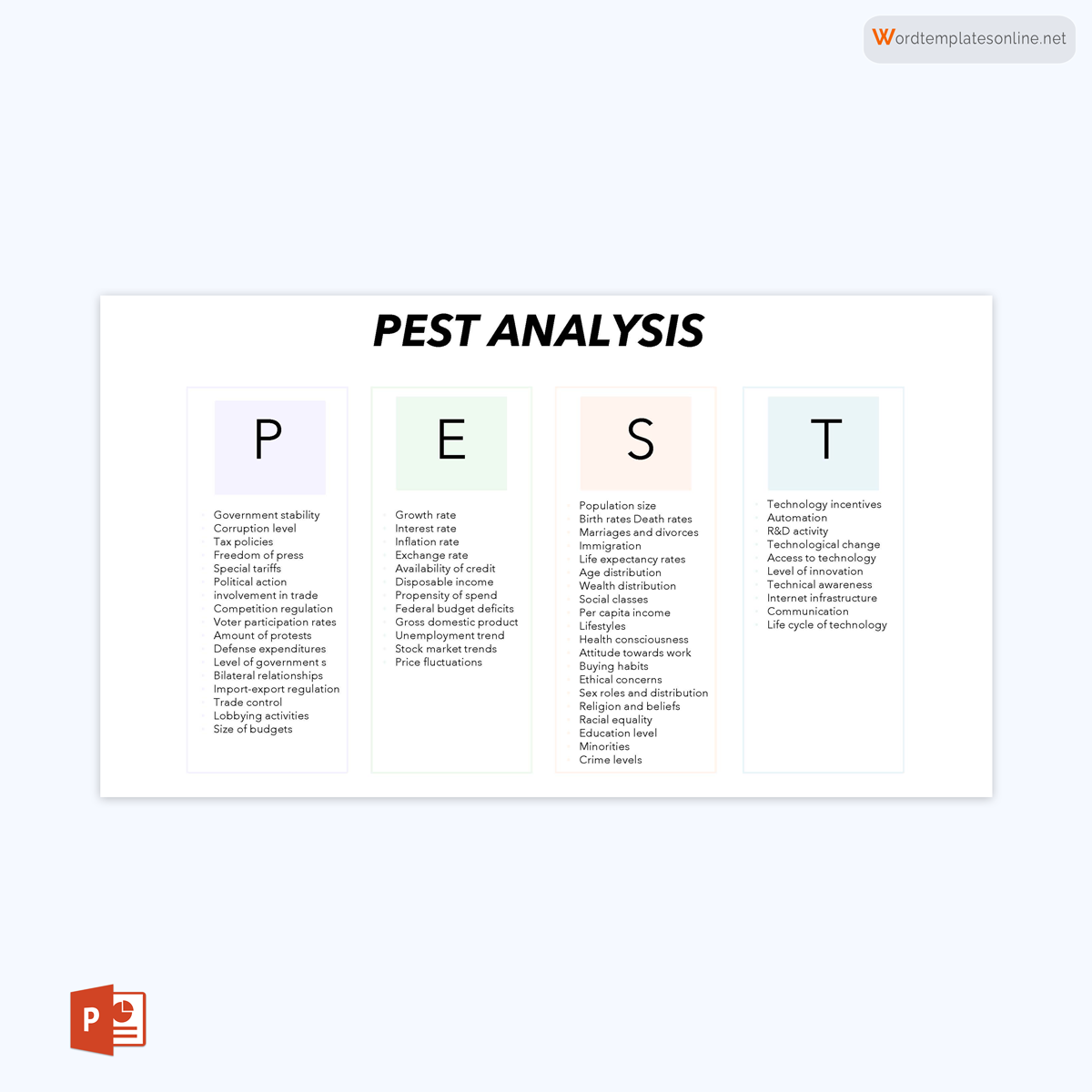
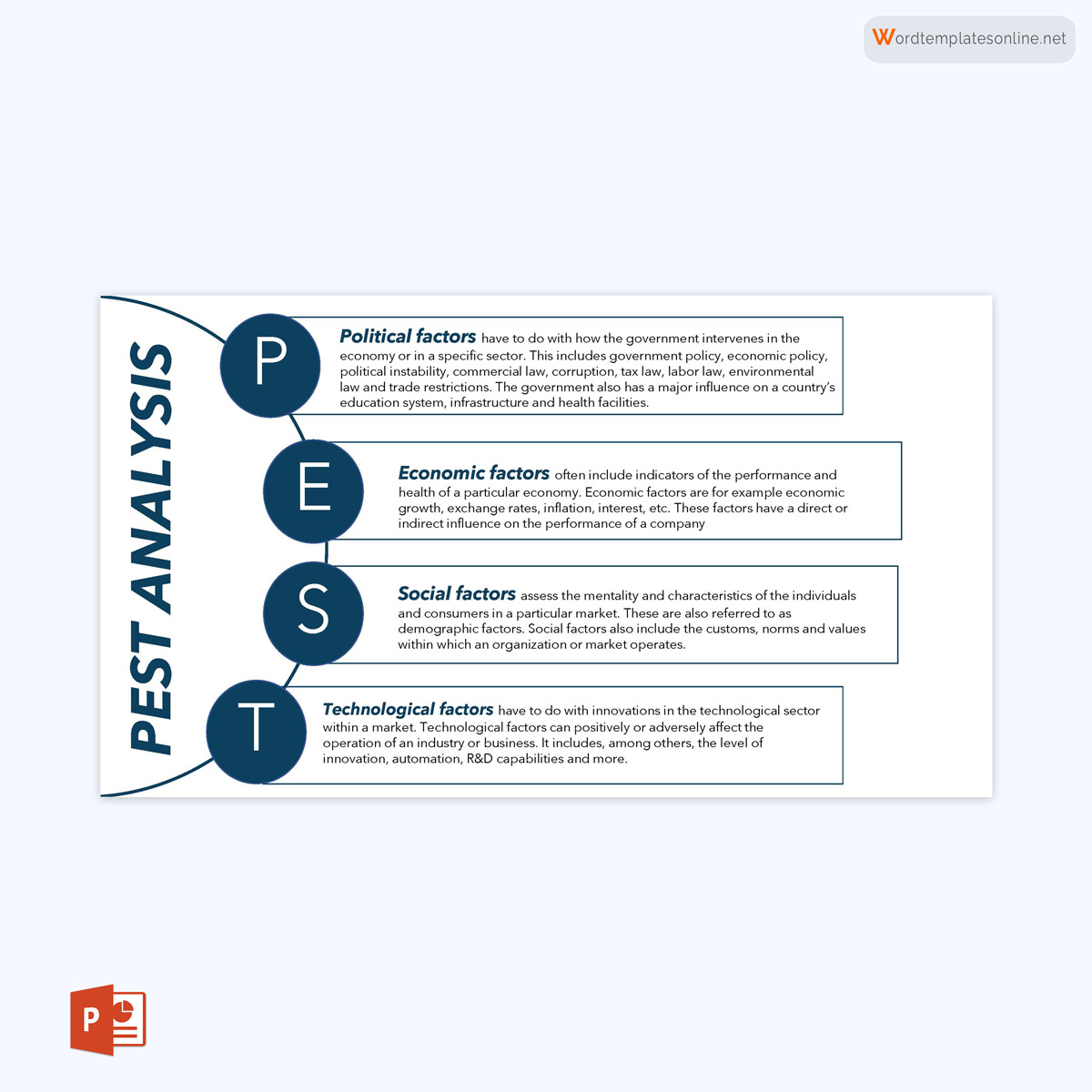
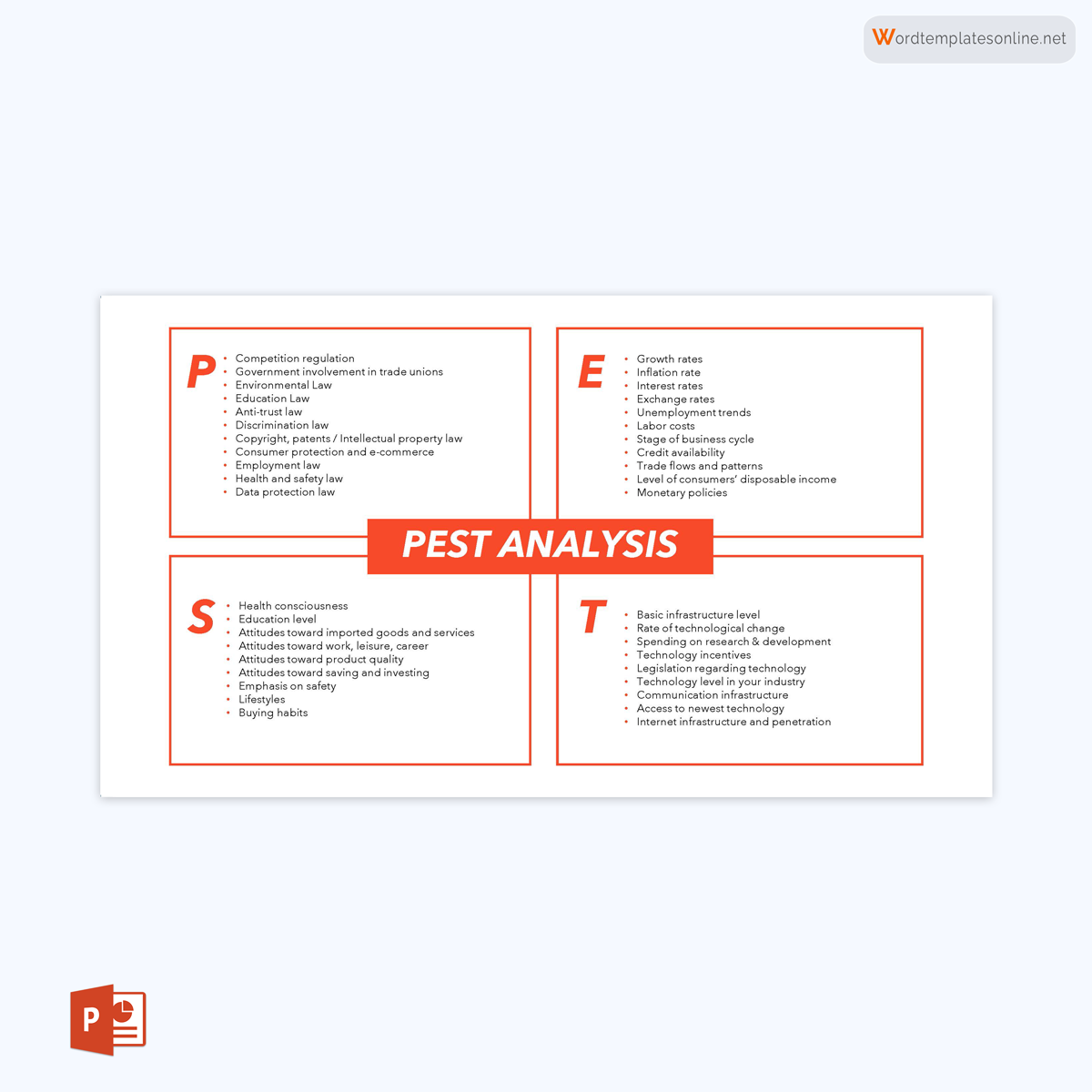
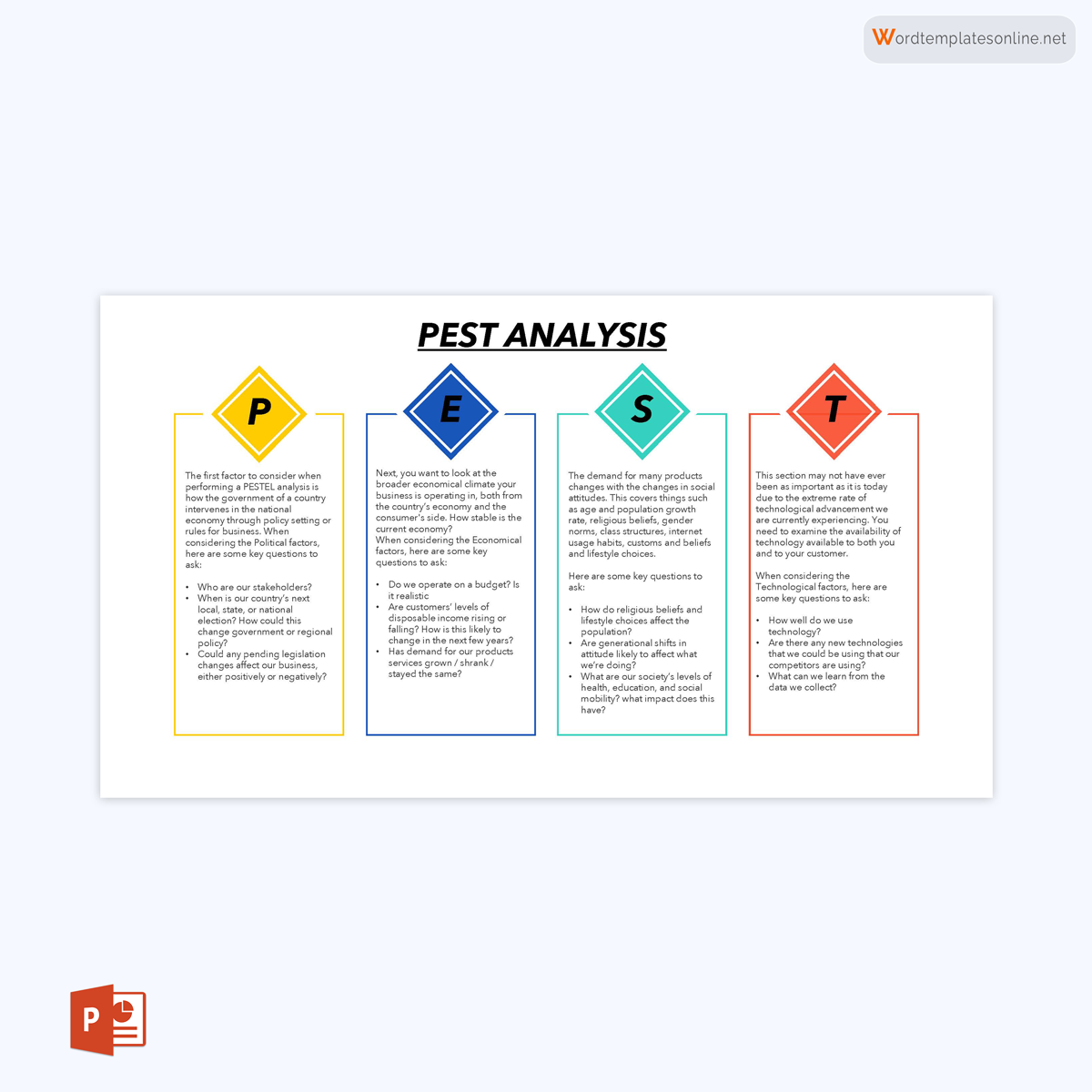
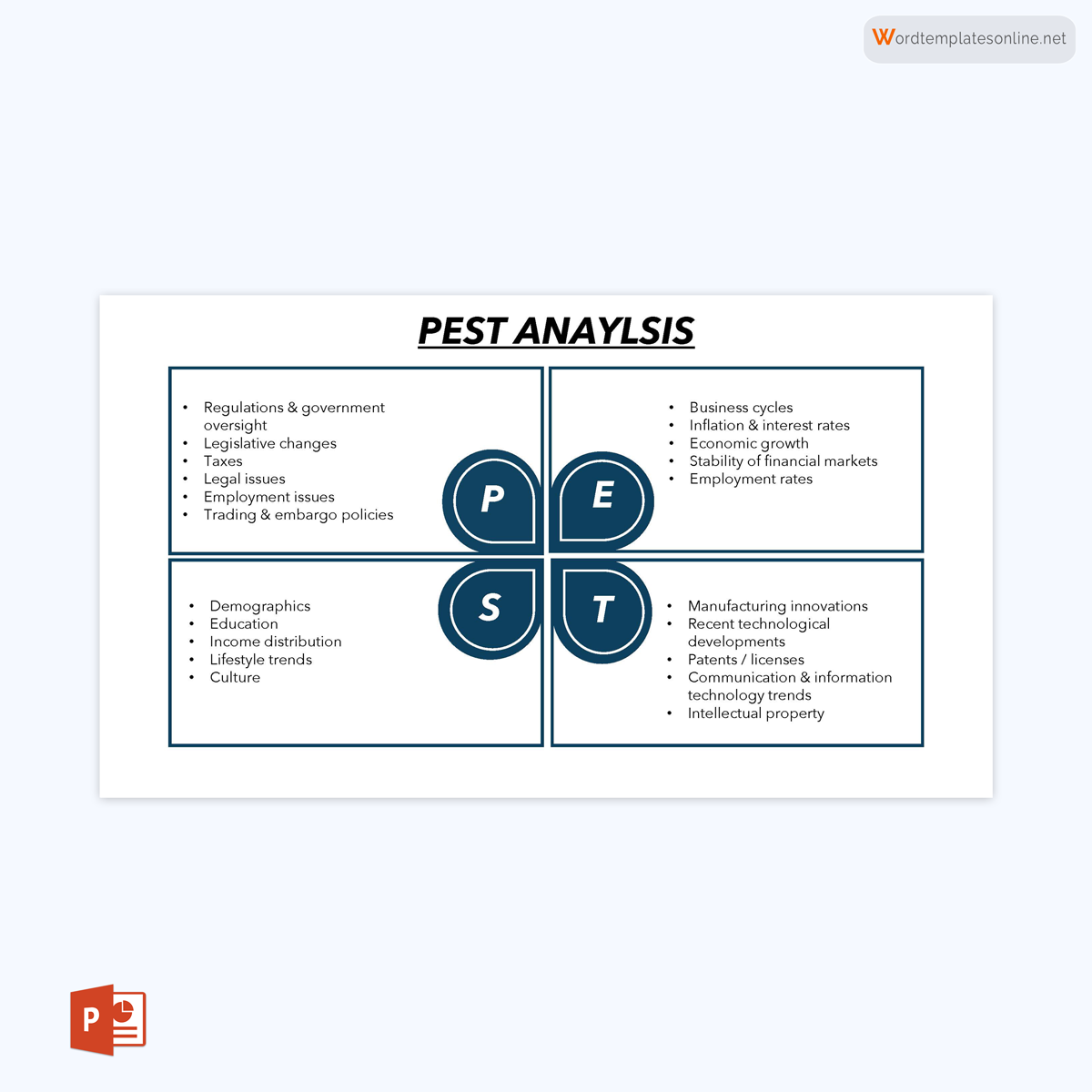
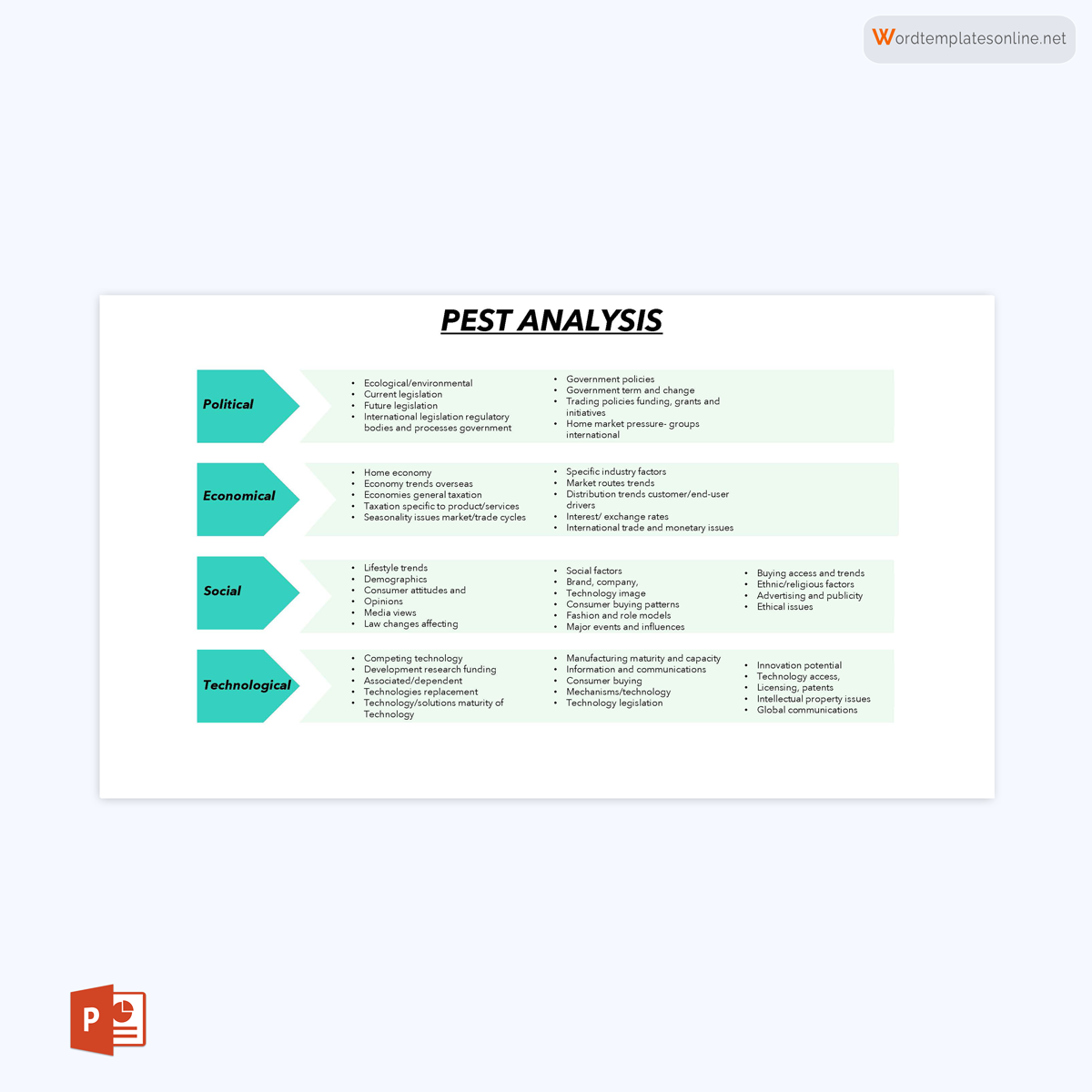
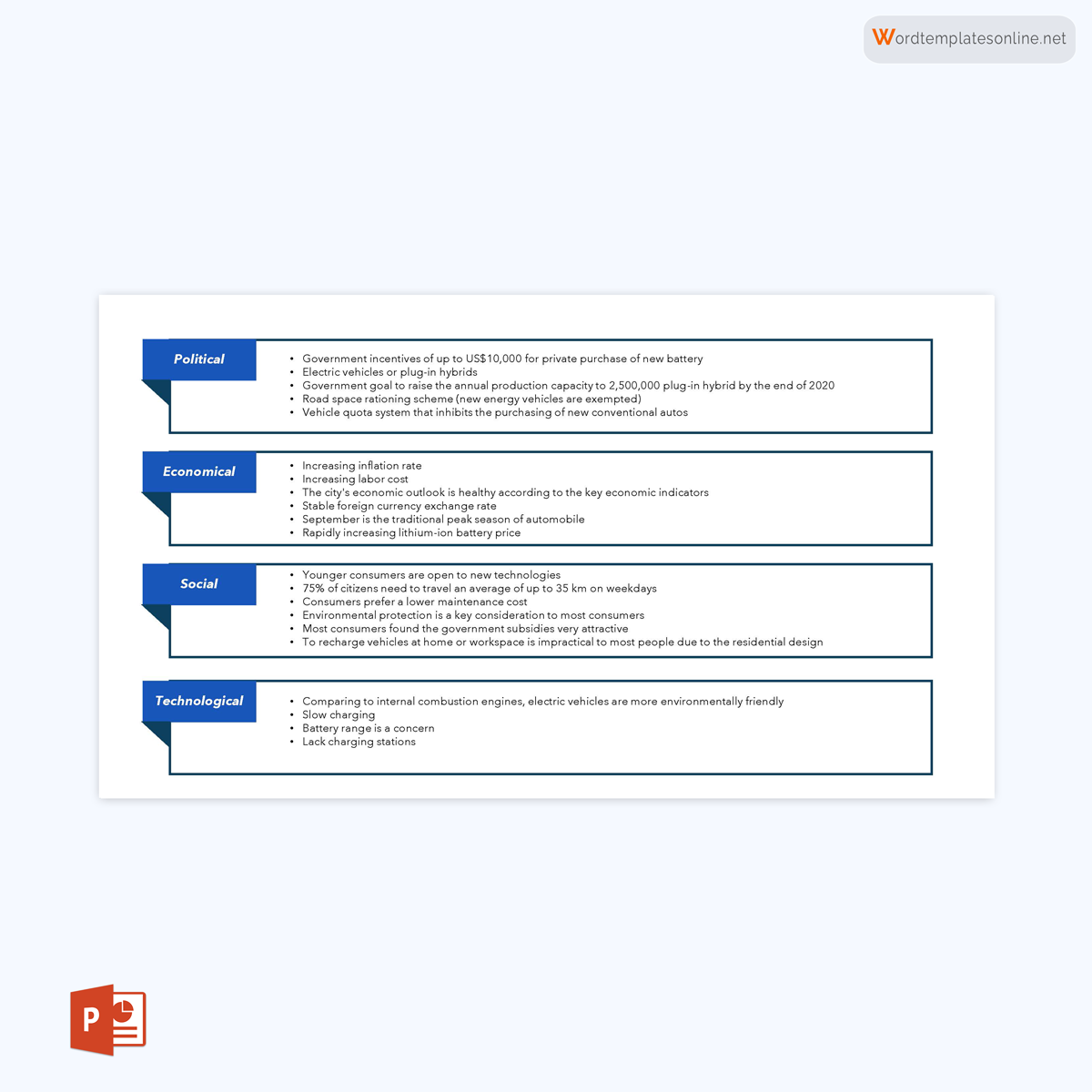
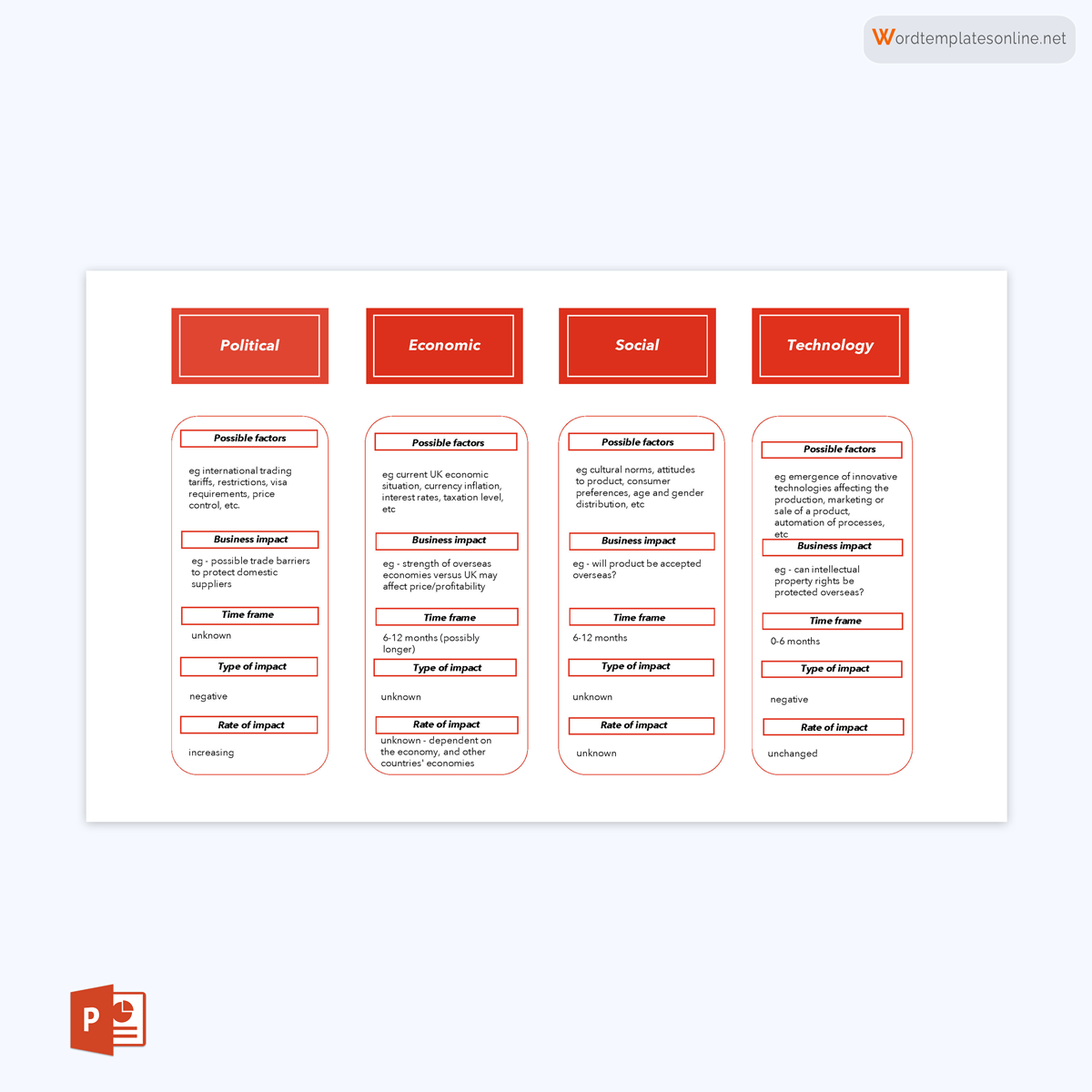
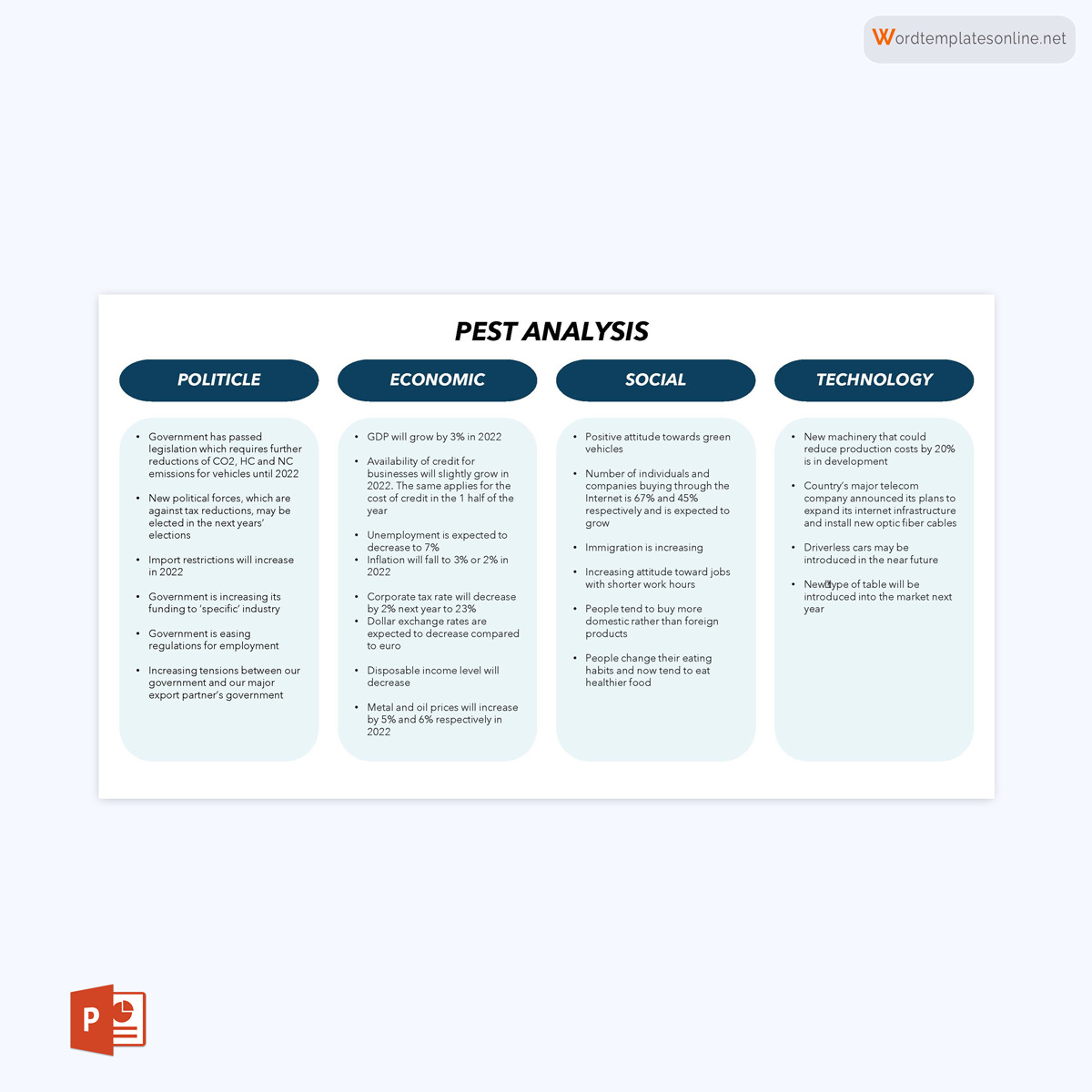
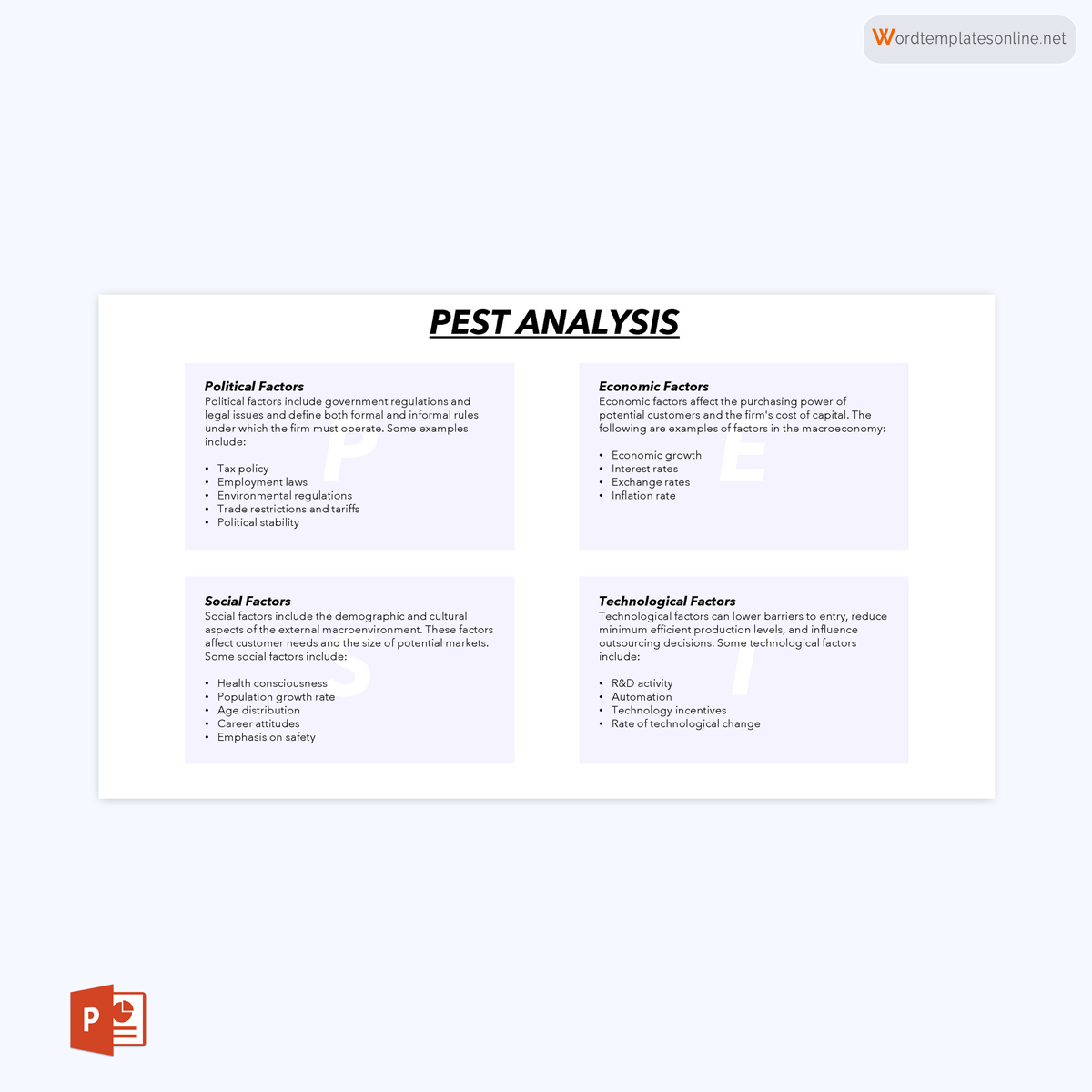

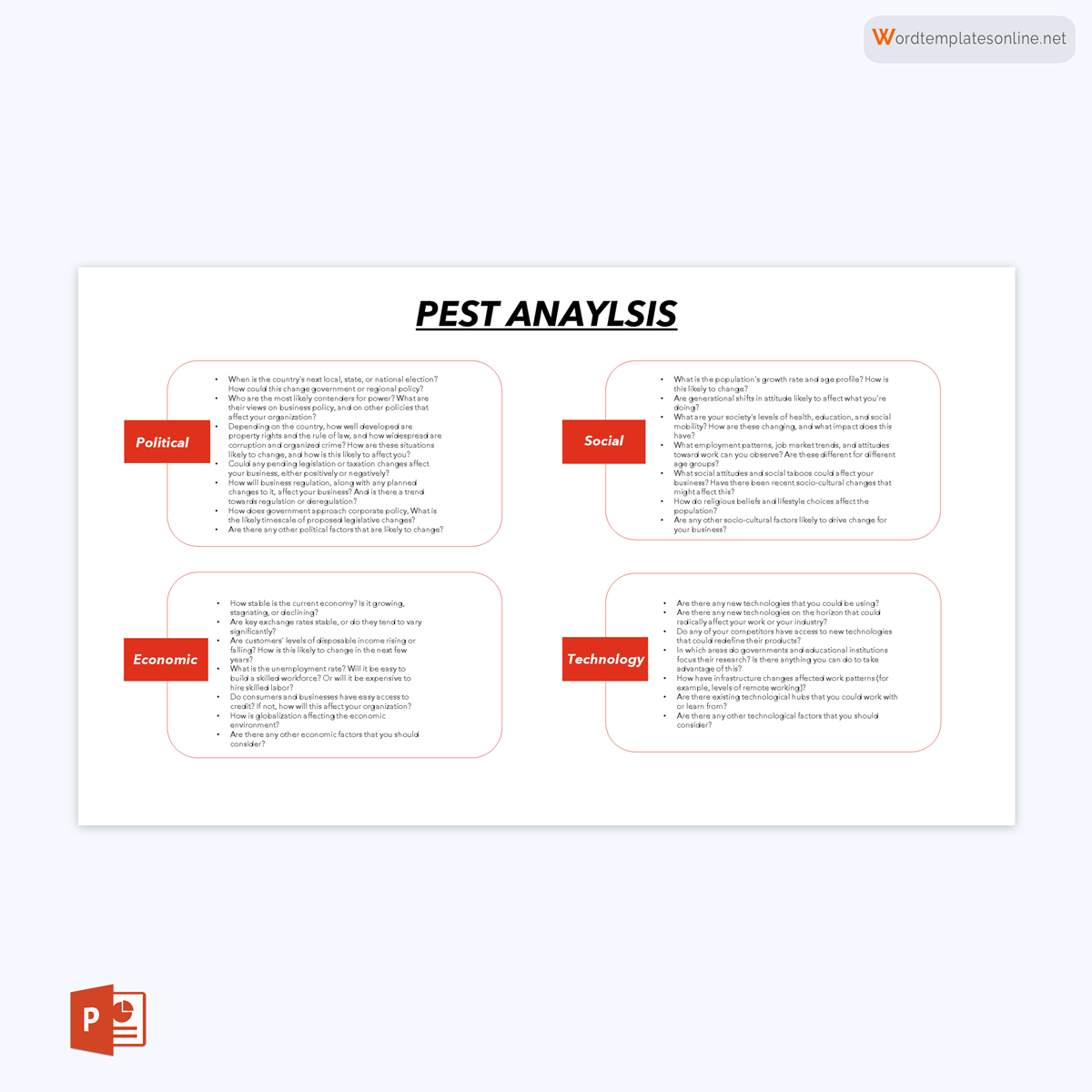
Who Needs PEST Analysis and Why?
This analysis is an excellent tool for helping both existing and new companies gain a strategic advantage in business. Its main purpose is to assess political, economic, social, and technological aspects (business environment) that may directly impact operations. As a result, the analysis is typically carried out by top-level management and c-level officer for strategic planning. Other parties known to partake in analysis are stakeholders, decision-makers, consultants, partners, external agencies, and bodies. PEST analysis are also used in project management and research.
Organisations will perform this analysis to identify threats and opportunities, changes in the business environment, and existing and potential risks in their business environment. Using the information obtained through the analysis, organisations can prepare accordingly, adapt their strategies to changes in the business environment, avoid pitfalls of business ventures and make informed decisions based on facts rather than assumptions.
Through such analysis, companies can make better decisions and implement strategies that benefit the broader external environment, thus increasing chances of success. Therefore, the analysis will be used for marketing, planning, business and product development, and structuring in organisations.
Areas Assessed by PEST Analysis
The PEST analysis looks into macro factors that affect the organisation/business from external forces. These external forces include political, economic, social, and technological forces.
Each factor has its significance in business:
- Political analysis – This aspect assesses how government policies and political status affect a particular industry or business. This analysis will look into multiple aspects such as taxes, legislation, laws, international relations, etc.
- Economic analysis – This area focuses on macroeconomic indicators such as inflation, unemployment, exchange rates, supply and demand, recession, etc.
- Social aspect – In this area, such analysis looks into the demographic and socioeconomic status impacting an organisation. This will include different social factors, including demographics and age distribution, cultural norms, lifestyle and workplace trends, etc.
- Technological analysis – This area looks into emerging technologies that are likely to affect a business or industry. Other factors analysed include government expenditure on technology research, trends, and changes in technology.
How to Use PEST Analysis
This analysis is a tool that can be used in various contexts and situations. It can be carried out at the beginning of a business venture to assess the factors that may affect business progression or for strategic planning for short-term goals. In addition, it can be conducted after an organisation has been in business for a significant time to identify a problem and find out its location and solution. When performing the analysis, each component is assessed independently and jointly to determine its impact on the organisation.
Below are the steps of carrying out an effective analysis:
Step 1: Brainstorm factors
The analysis initially begins with research to identify the various aspects of external factors that may impact an organisation. This may include macroeconomic factors such as the effects of inflation and the effect of economic policies on a certain industry. In order to obtain comprehensive data on external factors, one needs to create a list of all possible external factors that could have an effect on the industry or organisation and begin brainstorming by writing down any factor that might be relevant.
The main factors are as follows:
- Political factors to consider: Political factors are laws, governmental regulations, and influences regarding the production and distribution of goods and services. Government regulations and policies affect everything from taxes, investments and loans to labor laws, competition and trade agreements. All governments generally apply laws but vary depending on factors such as country type (developing versus developed), size, or political view. As a result, political factors vary across different regions. Other factors include corruption rates, planned policy changes, and national elections, etc.
- Economic factors to consider: The economy has a large impact on business operations. Companies will thus assess different aspects of the economy, such as the state of the economy (growth rates), exchange rates, customers’ disposable income and purchasing power, access to credit and interest rates, inflation, unemployment rate, effects of globalisation, and many other economic indicators. Economic conditions greatly influence the viability and sustainability of the business.
- Socio-cultural factors to consider: Social factors are the societal influences that affect a business on a grand scale. They affect the way people live, how they act, what they think and what they want. These factors include population growth rates, cultural aspects, age distribution, class structures, lifestyle choices, religious beliefs, health, education levels, employment patterns, career attitudes, demographic trends, social attitudes, behaviours, and trends.
- Technological factors to consider: The technological environment is constantly changing. New technological innovations occur at a rapid rate, requiring companies to update their strategies to be up-to-date every now and then. Some technological factors include technological incentives, automation, R&D activity, and the rate of change in technology.
Step 2: Review responses and collate ideas
After brainstorming the factors, gather responses and ideas from participants and ask for their input. Collate ideas to capitalize on the available opportunities that exist with changes in the external environment. Review responses and collate ideas for each component of the analysis.
Step 3: Rate the ideas
Next, rate the ideas based on how effectively they fit the current market, industry conditions, and organisation goals. Consult the participants during this exercise. This will help determine if certain factors are more influential than others and which factors need to be focused on to manage the organisation’s operations better. Factors are then prioritised based on potential effects, determining which factors should be given greater attention. Priorities will vary from one industry to another.
Step 4: Brainstorm threats
After prioritising and ranking the factors that have a greater influence on the organisation, one can then brainstorm possible threats to each factor. Threats may refer to changes in human behaviour as well as changes in legislation, social attitudes, and cultural values. Assess factors that directly or indirectly impact organisational strategies and operations in order to identify any weaknesses that need to be addressed. This helps companies avoid problems entirely or mitigate the potential impacts.
Step 5: Share the outcomes and take action
Lastly, after completing the analysis, it may be necessary to document the outcomes regarding the potential opportunities and risks/threats. If a significant risk needs immediate attention, one can inform relevant parties or stakeholders and request that they participate in risk mitigation strategies. The report can then be used to monitor progress and for reference in the future.
Applications of PEST Analysis
Increasingly, this analysis is being used as a tool for strategic planning to help organisations better capitalise on opportunities by anticipating potential threats and designing responses, depending on the current external environment and their current and future plans and goals. The analysis is also used to evaluate internal forces in the same areas as PEST analysis – internal politics, economic forces, social climate, and technology level. This is used to make improvements and changes in areas where the organisation falls short.
Additionally, PEST analysis is performed jointly with other strategic planning analyses, such as SWOT analysis, to formulate more comprehensive strategies. These two frameworks will examine consistent aspects of the business; the approach can help gain unique and distinct information that provides a better basis for decision-making.
PEST analysis is performed as part of a DCF Valuation Model. This is because the political, economic, social, and technological factors greatly influence the opportunities and threats a business will face and, consequently, its potential profitability. This directly impacts a business’s valuation in the future. This analysis ensures all these factors are considered during valuation as criteria for valuation.
Variations of PEST Analysis
There are several ways to conduct this analysis. Although the basic one remains the same, the approach has several alterations, such as prioritising factors. This leads to variations in the analysis.
Examples of these variations include:
PESTLE/PESTEL
This variation incorporates two additional components to the analysis that are Legal and Environmental factors on top of the political, economic, social-cultural, and technological factors. The legal factors can take priority over environmental factors or vice versa as applicable to the type of industry.
PESTLIED
The PESTLIED approach is a variation of the original analysis that includes legal, international, environmental, and demographic factors. The PEST base remains unchanged.
STEEPLE
The STEEPLE refers to social, technological, economic, environmental, political, legal, and ethical factors. The order of priority assigned to the factors is different from that of a standard analysis.
SLEPT
This variation adds to the legal aspect of the business environment. However, this aspect is given a higher priority as the factors are assessed as follows – socio-cultural, legal, economic, political, and technological factors.
LONGPESTLE
Here as well, the base remains unchanged. This variation takes into account the local (LO), national (N), and global (G) factors of the PESTLE analysis. It is suited for multinational organisations.
Final Thoughts
PEST analysis is a powerful tool that can be used to assume and assess possible threats, opportunities, and their impacts on the viability and sustainability of any organisation. This information is used to develop strategies that capitalise on the opportunities, thus giving the organisation a competitive advantage over its competitors. The analysis focuses on external factors of the business environment in which the company is based. If properly carried out, the analysis can positively contribute to the organisation’s success by helping management make better decisions.











